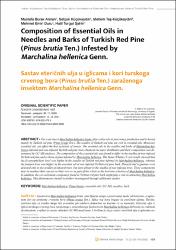Composition of Essential Oils in Needles and Barks of Turkish Red Pine (Pinus brutia Ten.) Infested by Marchalina hellenica Genn.

View/
Date
2022Author
Arslan Burak, MustafaKüçükaydın, Selçuk
Taş-Küçükaydın, Mustafa
Duru, Mehmet Emin
Şahin, Halil Turgut
Metadata
Show full item recordCitation
Arslan, Mustafa Burak, et al. "Composition of Essential Oils in Needles and Barks of Turkish Red Pine (Pinus brutia Ten.) Infested by Marchalina hellenica Genn." Drvna industrija 73.2 (2022): 125-138.Abstract
The scale insect Marchalina hellenica Genn. plays a key role in pine honey production and is hosted mainly by Turkish red pine (Pinus brutia Ten.). The needles of Turkish red pine are rich in essential oils. Moreover, essential oils can affect the host selection of insects. The essential oils in the needles and barks of Marchalina hellenica-infested and non-infested Turkish red pine were obtained via water distillation and their composition was determined by GC-MS analyses. The composition of the essential oils was found to differ in the needles of non-infested Turkish red pine and in those of pine infested by Marchalina hellenica. The Mann-Whitney U test results showed that the beta-caryophyllene level was higher in the needles of Turkish red pine infested by Marchalina hellenica, whereas the junipen level was higher in the essential oil of non-infested Turkish red pine bark. Pimaral and alpha-guaiene were detected only in the needles of infested trees, but were absent in the needles of non-infested trees. These components may be markers that can act on their own or as part of the whole in the host tree selection of Marchalina hellenica. In addition, the cis-verbenone component found in Turkish red pine bark might play a role in attracting Marchalina hellenica. This phenomenon should be further investigated through additional studies.

















